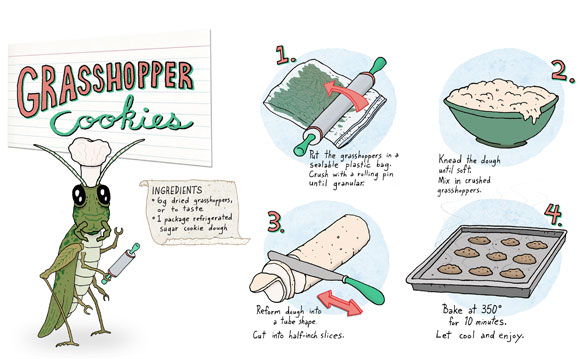
Eye on the Quads
Patience, Grasshopper
A student team wins $10K for a long-term project: make us eat bugs.
By Carrie Golus, AB’91, AM’93 | Illustration by Matthew Elliott
It was a sweet ending to a serious presentation. Matthew Krisiloff, ’14, leader of the team Entom Foods, served the judges homemade grasshopper cookies—named for the crushed, toasted grasshoppers inside.
“The cookies were great,” says Michelle Kristula-Green, AB’77, AM’83, one of the six judges at the first annual Innovation Competition, run by Career Advising and Planning Services. “It made the idea of eating insects palatable and easy to try.”
The competition was sponsored by three of the Chicago Careers In … (CCI) programs. Students from CCIST (science and technology), CCIPSS (public and social service), and CCIB (business), working in teams of three to six, had to dream up a business plan that used technology to make a positive social impact.
Chelsey Rice-Davis, ’13, of the Entom Foods team, is quick to point out that cookies are “not our ideal product.” Entom has yet to settle on that ideal product, but it has an audacious goal: to make entomophagy—insect consumption—an everyday practice in the West.
The judges were convinced. Entom Foods, which also includes Irvin Ho, ’13; Ben C. Yu, ’14; and Tommy Wu, ’13, won the $10,000 prize, beating out four other teams that had made it to the semifinals. A total of 115 students on 26 teams entered the Innovation Competition.
“Meat consumption is extremely environmentally costly,” Entom wrote in its proposal. It’s also inefficient: for every ten grams of feed, just one gram of beef is produced, compared to nine grams of edible insect meat. As for nutrition, insect meat is similar, if not a little healthier. The thorax meat of locusts, the team wrote, “contains the same amount of protein, iron, calcium, and calories as beef per gram, but with less saturated fat.”
Eighty percent of the world’s population has already figured this out, according to Rice-Davis. “As Westerners, we’re in the minority in not eating insects,” she says. “We’re the strange ones.”
For Entom member Ben Yu, who was born in China, Western revulsion is difficult to understand: “It’s not abhorrent at all.” To someone from Asia or Africa, he says, “the taboo on eating insects here is almost like culture shock.”
“As with all foods, they should pass regulations and have proper treatment before they are put to market,” says another Entom member, Tommy Wu, who grew up in Manchuria. He last enjoyed his favorite insect dish, fried and glazed cicadas, at his grandmother’s 70th birthday celebration. “I’m totally fine with eating locusts or mealworms that are commercially produced and tested.”
But for Western consumers, the team admitted in its proposal, “the multiple wings, the beady eyes, the slimy legs … all contribute to an overall ‘ick’ factor.” Entom’s brilliant solution: food processing. The shelling machines currently used for lobsters and other crustaceans could be adapted for insects, the team proposes. The wings, legs, eyes, and other gross parts would be whisked away, leaving the thorax meat, “which is nutritious and has the same consistency as more traditional meats.”
Entom has not yet chosen which insect to attempt to commercialize. One possibility is the long-horned grasshopper, which reportedly tastes like a hybrid of butter, bacon, and chicken and is a beloved foodstuff in Uganda. Another is the giant prickly stick insect; at eight inches long, this creature could supply a lot of meat. “We’re obviously going to avoid the super-stigmatized insects, like cockroaches and flies,” says Krisiloff, “which wouldn’t have substantive meat on them anyway.”
With the $10,000 award, Krisiloff, and possibly other members of the team, plan to travel to Wageningen University in the Netherlands to work with leading entomophagists Marcel Dicke and Arnold Van Huis. The team hopes to come up with a commercially viable product by the end of the summer.
For Entom, persuading Westerners to eat insects is not about trying to produce novelty items—like the chocolate-covered ants or salt-and-vinegar crickets already available here—but rather a viable substitute for traditional meat. “By switching to insect consumption in any capacity, we can reduce our global footprint,” says Rice-Davis.
And it’s important to do it now, says Krisiloff: “As countries industrialize and their economies develop, they imitate our food practices. Eating beef and chicken is a sign they’ve come up in the world.” Anecdotally, says Krisiloff, entomophagists have noticed that insect consumption is declining around the world in favor of Western food practices.
Krisiloff has already won over a few insect skeptics, including his own parents: “My mom’s first reaction was, ‘We pay $50,000 for you to come here and this is what you’re doing with your time?’ But now they see it as a cool idea,” he says. “The social stigma is what makes it interesting for me.”
